Change Management in Enhanced Engineering and Multi-Technologies Co.
VerifiedAdded on 2023/04/21
|12
|2808
|457
AI Summary
This report focuses on the change management in Enhanced Engineering and Multi-Technologies Co. (EEMC) and evaluates the benefits and competencies faced by managers during the change process.
Contribute Materials
Your contribution can guide someone’s learning journey. Share your
documents today.
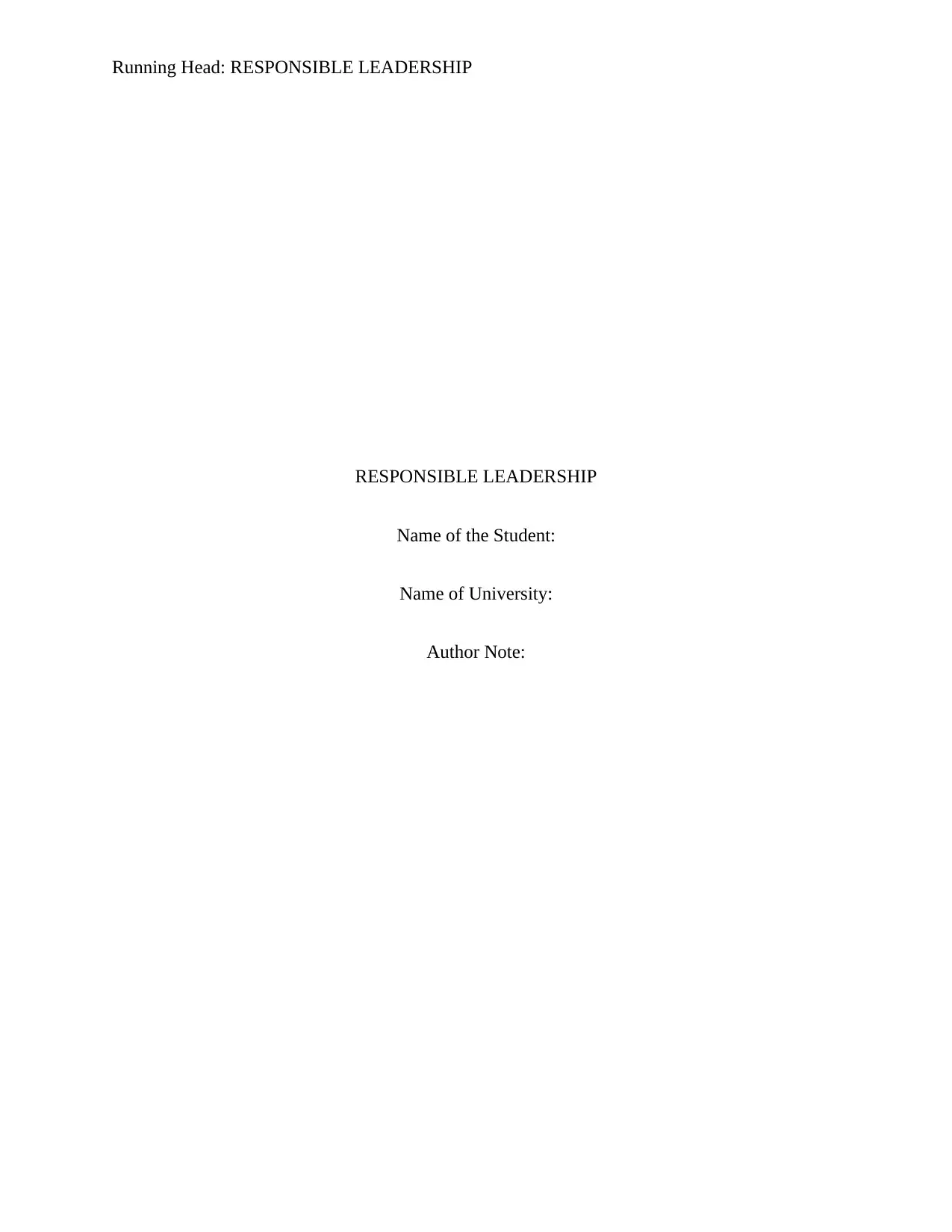
Running Head: RESPONSIBLE LEADERSHIP
RESPONSIBLE LEADERSHIP
Name of the Student:
Name of University:
Author Note:
RESPONSIBLE LEADERSHIP
Name of the Student:
Name of University:
Author Note:
Secure Best Marks with AI Grader
Need help grading? Try our AI Grader for instant feedback on your assignments.
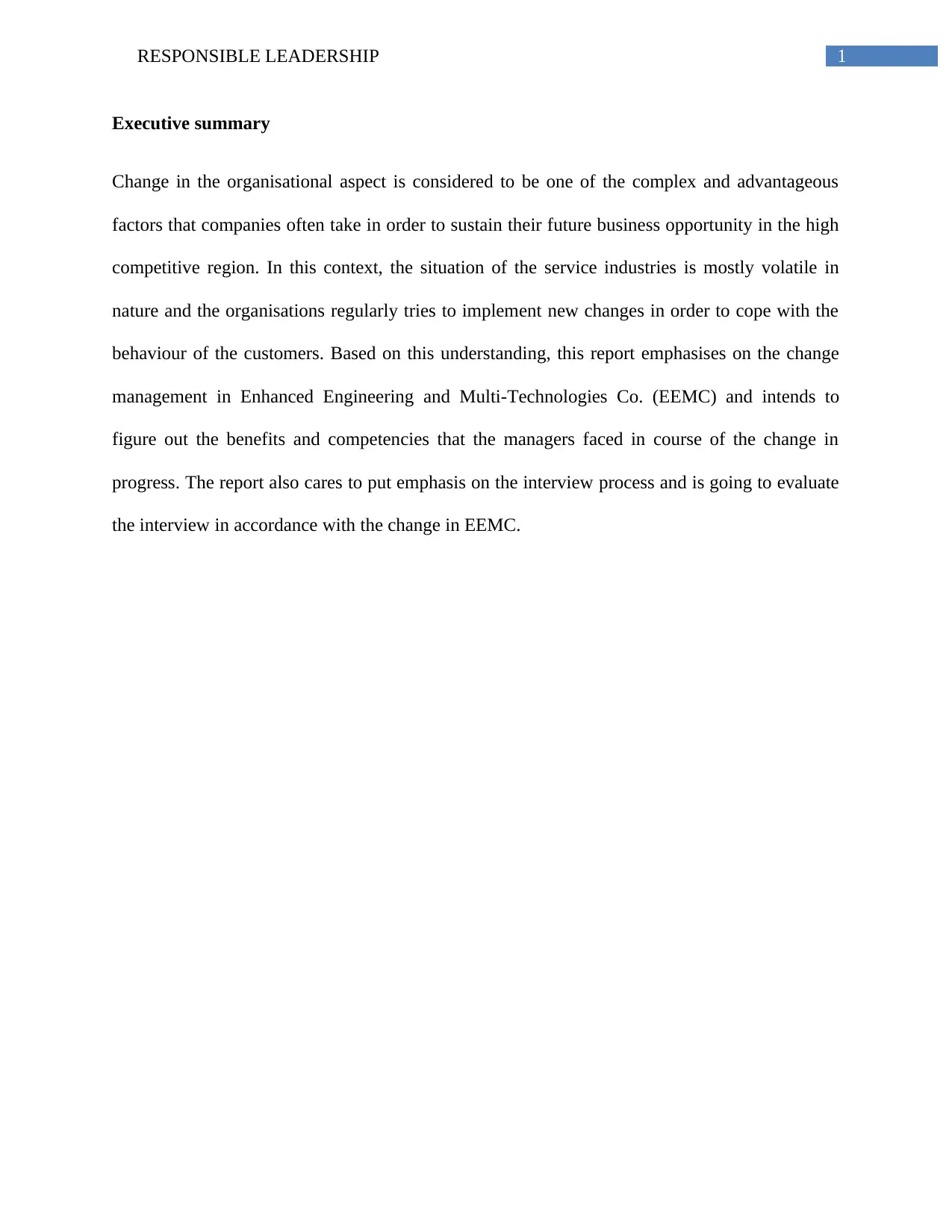
1RESPONSIBLE LEADERSHIP
Executive summary
Change in the organisational aspect is considered to be one of the complex and advantageous
factors that companies often take in order to sustain their future business opportunity in the high
competitive region. In this context, the situation of the service industries is mostly volatile in
nature and the organisations regularly tries to implement new changes in order to cope with the
behaviour of the customers. Based on this understanding, this report emphasises on the change
management in Enhanced Engineering and Multi-Technologies Co. (EEMC) and intends to
figure out the benefits and competencies that the managers faced in course of the change in
progress. The report also cares to put emphasis on the interview process and is going to evaluate
the interview in accordance with the change in EEMC.
Executive summary
Change in the organisational aspect is considered to be one of the complex and advantageous
factors that companies often take in order to sustain their future business opportunity in the high
competitive region. In this context, the situation of the service industries is mostly volatile in
nature and the organisations regularly tries to implement new changes in order to cope with the
behaviour of the customers. Based on this understanding, this report emphasises on the change
management in Enhanced Engineering and Multi-Technologies Co. (EEMC) and intends to
figure out the benefits and competencies that the managers faced in course of the change in
progress. The report also cares to put emphasis on the interview process and is going to evaluate
the interview in accordance with the change in EEMC.
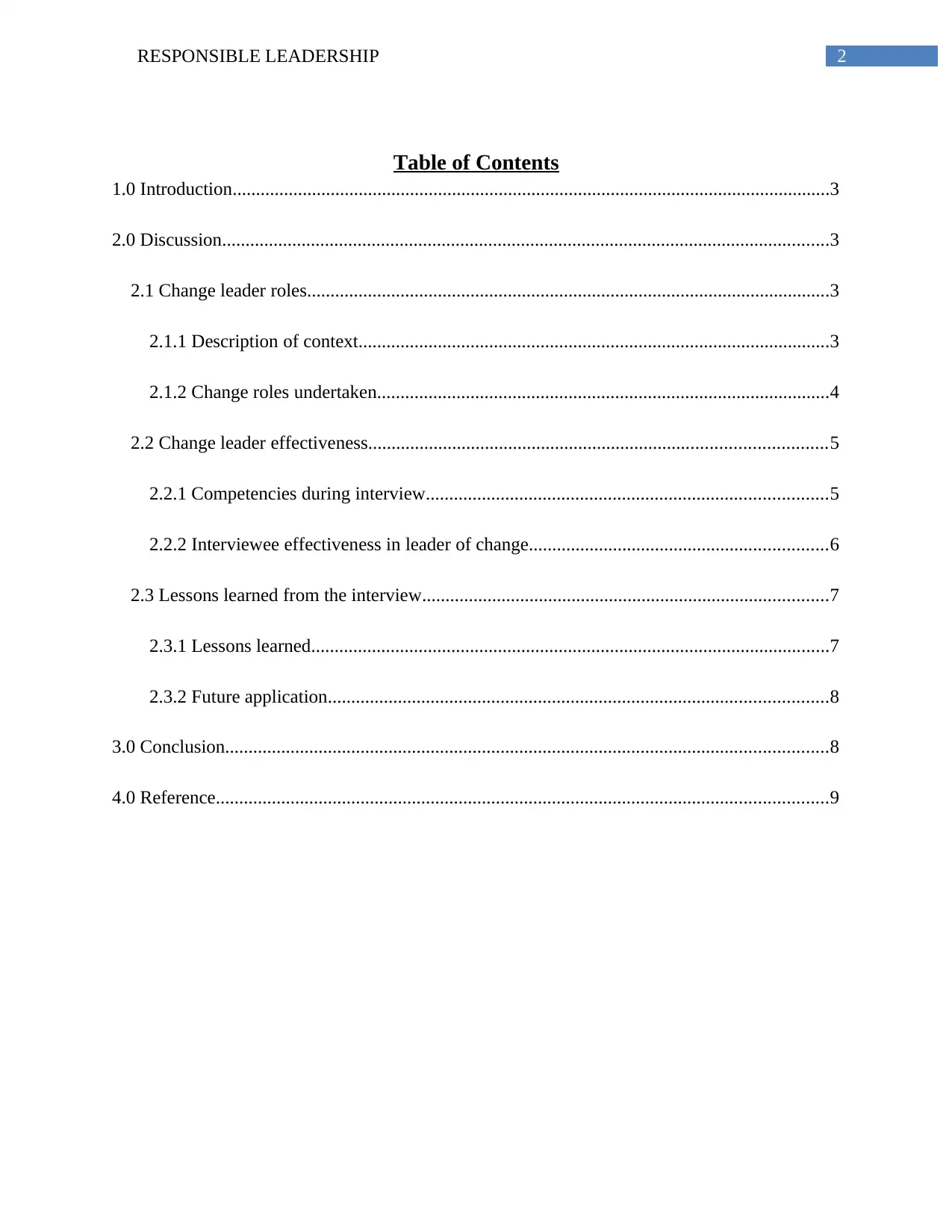
2RESPONSIBLE LEADERSHIP
Table of Contents
1.0 Introduction................................................................................................................................3
2.0 Discussion..................................................................................................................................3
2.1 Change leader roles................................................................................................................3
2.1.1 Description of context.....................................................................................................3
2.1.2 Change roles undertaken.................................................................................................4
2.2 Change leader effectiveness..................................................................................................5
2.2.1 Competencies during interview......................................................................................5
2.2.2 Interviewee effectiveness in leader of change................................................................6
2.3 Lessons learned from the interview.......................................................................................7
2.3.1 Lessons learned...............................................................................................................7
2.3.2 Future application...........................................................................................................8
3.0 Conclusion.................................................................................................................................8
4.0 Reference...................................................................................................................................9
Table of Contents
1.0 Introduction................................................................................................................................3
2.0 Discussion..................................................................................................................................3
2.1 Change leader roles................................................................................................................3
2.1.1 Description of context.....................................................................................................3
2.1.2 Change roles undertaken.................................................................................................4
2.2 Change leader effectiveness..................................................................................................5
2.2.1 Competencies during interview......................................................................................5
2.2.2 Interviewee effectiveness in leader of change................................................................6
2.3 Lessons learned from the interview.......................................................................................7
2.3.1 Lessons learned...............................................................................................................7
2.3.2 Future application...........................................................................................................8
3.0 Conclusion.................................................................................................................................8
4.0 Reference...................................................................................................................................9
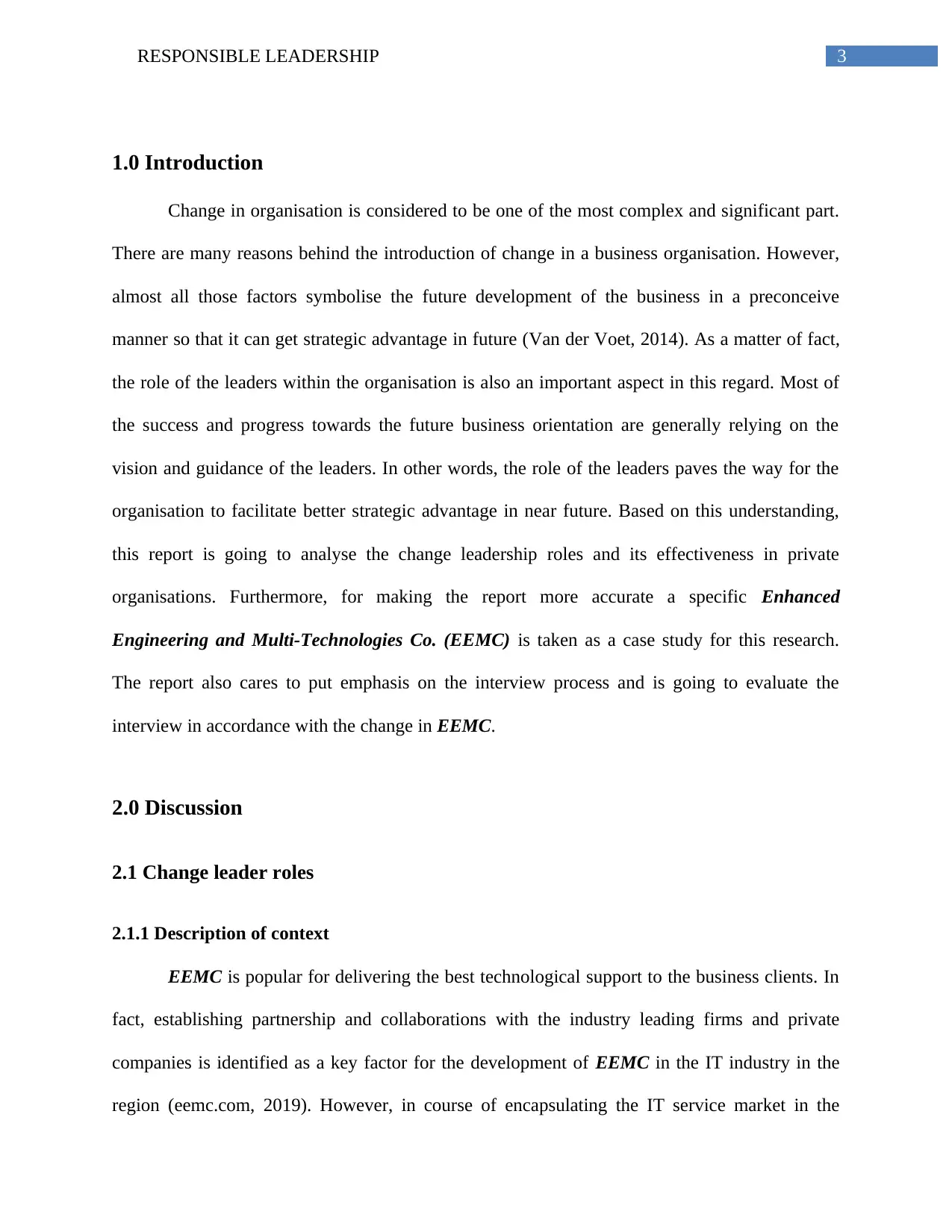
3RESPONSIBLE LEADERSHIP
1.0 Introduction
Change in organisation is considered to be one of the most complex and significant part.
There are many reasons behind the introduction of change in a business organisation. However,
almost all those factors symbolise the future development of the business in a preconceive
manner so that it can get strategic advantage in future (Van der Voet, 2014). As a matter of fact,
the role of the leaders within the organisation is also an important aspect in this regard. Most of
the success and progress towards the future business orientation are generally relying on the
vision and guidance of the leaders. In other words, the role of the leaders paves the way for the
organisation to facilitate better strategic advantage in near future. Based on this understanding,
this report is going to analyse the change leadership roles and its effectiveness in private
organisations. Furthermore, for making the report more accurate a specific Enhanced
Engineering and Multi-Technologies Co. (EEMC) is taken as a case study for this research.
The report also cares to put emphasis on the interview process and is going to evaluate the
interview in accordance with the change in EEMC.
2.0 Discussion
2.1 Change leader roles
2.1.1 Description of context
EEMC is popular for delivering the best technological support to the business clients. In
fact, establishing partnership and collaborations with the industry leading firms and private
companies is identified as a key factor for the development of EEMC in the IT industry in the
region (eemc.com, 2019). However, in course of encapsulating the IT service market in the
1.0 Introduction
Change in organisation is considered to be one of the most complex and significant part.
There are many reasons behind the introduction of change in a business organisation. However,
almost all those factors symbolise the future development of the business in a preconceive
manner so that it can get strategic advantage in future (Van der Voet, 2014). As a matter of fact,
the role of the leaders within the organisation is also an important aspect in this regard. Most of
the success and progress towards the future business orientation are generally relying on the
vision and guidance of the leaders. In other words, the role of the leaders paves the way for the
organisation to facilitate better strategic advantage in near future. Based on this understanding,
this report is going to analyse the change leadership roles and its effectiveness in private
organisations. Furthermore, for making the report more accurate a specific Enhanced
Engineering and Multi-Technologies Co. (EEMC) is taken as a case study for this research.
The report also cares to put emphasis on the interview process and is going to evaluate the
interview in accordance with the change in EEMC.
2.0 Discussion
2.1 Change leader roles
2.1.1 Description of context
EEMC is popular for delivering the best technological support to the business clients. In
fact, establishing partnership and collaborations with the industry leading firms and private
companies is identified as a key factor for the development of EEMC in the IT industry in the
region (eemc.com, 2019). However, in course of encapsulating the IT service market in the
Secure Best Marks with AI Grader
Need help grading? Try our AI Grader for instant feedback on your assignments.
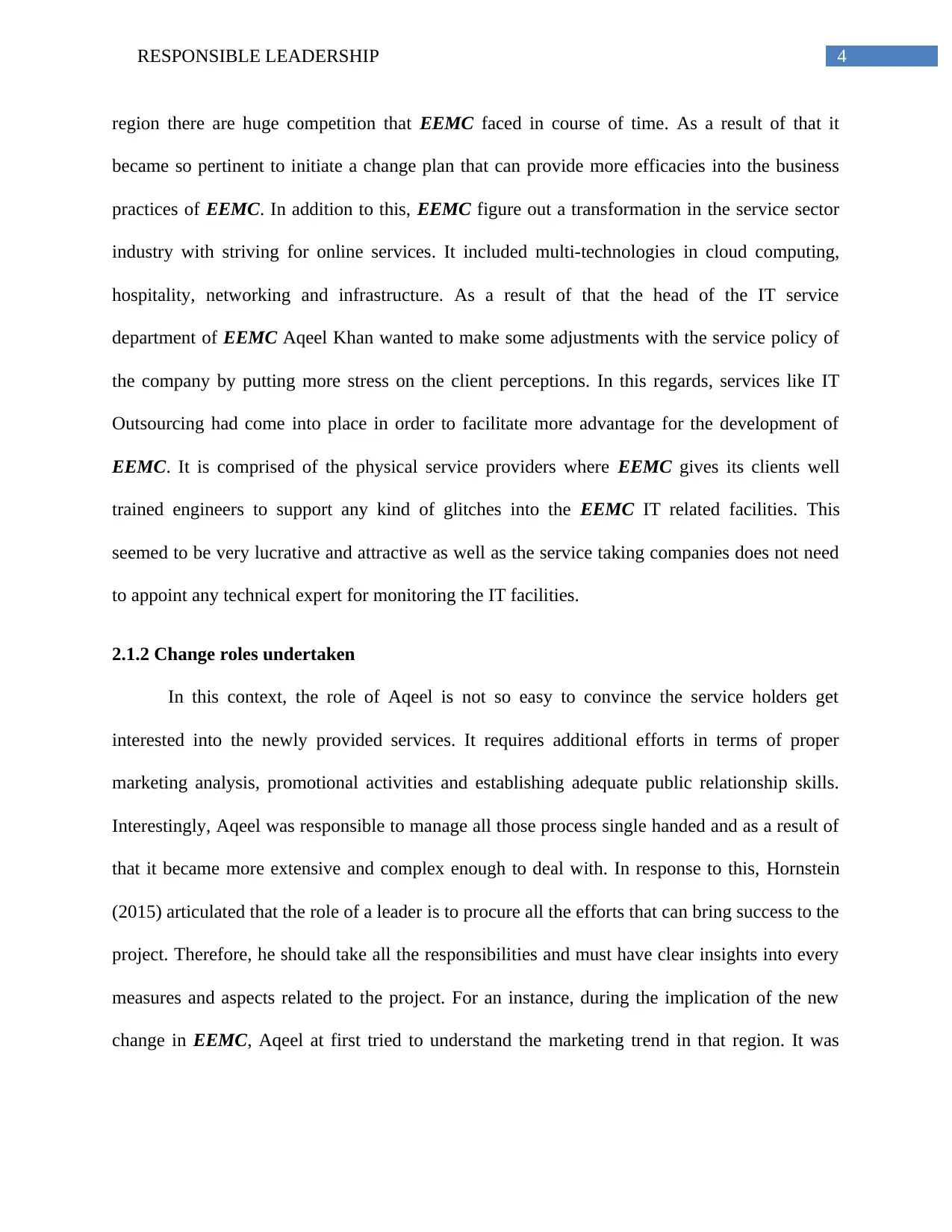
4RESPONSIBLE LEADERSHIP
region there are huge competition that EEMC faced in course of time. As a result of that it
became so pertinent to initiate a change plan that can provide more efficacies into the business
practices of EEMC. In addition to this, EEMC figure out a transformation in the service sector
industry with striving for online services. It included multi-technologies in cloud computing,
hospitality, networking and infrastructure. As a result of that the head of the IT service
department of EEMC Aqeel Khan wanted to make some adjustments with the service policy of
the company by putting more stress on the client perceptions. In this regards, services like IT
Outsourcing had come into place in order to facilitate more advantage for the development of
EEMC. It is comprised of the physical service providers where EEMC gives its clients well
trained engineers to support any kind of glitches into the EEMC IT related facilities. This
seemed to be very lucrative and attractive as well as the service taking companies does not need
to appoint any technical expert for monitoring the IT facilities.
2.1.2 Change roles undertaken
In this context, the role of Aqeel is not so easy to convince the service holders get
interested into the newly provided services. It requires additional efforts in terms of proper
marketing analysis, promotional activities and establishing adequate public relationship skills.
Interestingly, Aqeel was responsible to manage all those process single handed and as a result of
that it became more extensive and complex enough to deal with. In response to this, Hornstein
(2015) articulated that the role of a leader is to procure all the efforts that can bring success to the
project. Therefore, he should take all the responsibilities and must have clear insights into every
measures and aspects related to the project. For an instance, during the implication of the new
change in EEMC, Aqeel at first tried to understand the marketing trend in that region. It was
region there are huge competition that EEMC faced in course of time. As a result of that it
became so pertinent to initiate a change plan that can provide more efficacies into the business
practices of EEMC. In addition to this, EEMC figure out a transformation in the service sector
industry with striving for online services. It included multi-technologies in cloud computing,
hospitality, networking and infrastructure. As a result of that the head of the IT service
department of EEMC Aqeel Khan wanted to make some adjustments with the service policy of
the company by putting more stress on the client perceptions. In this regards, services like IT
Outsourcing had come into place in order to facilitate more advantage for the development of
EEMC. It is comprised of the physical service providers where EEMC gives its clients well
trained engineers to support any kind of glitches into the EEMC IT related facilities. This
seemed to be very lucrative and attractive as well as the service taking companies does not need
to appoint any technical expert for monitoring the IT facilities.
2.1.2 Change roles undertaken
In this context, the role of Aqeel is not so easy to convince the service holders get
interested into the newly provided services. It requires additional efforts in terms of proper
marketing analysis, promotional activities and establishing adequate public relationship skills.
Interestingly, Aqeel was responsible to manage all those process single handed and as a result of
that it became more extensive and complex enough to deal with. In response to this, Hornstein
(2015) articulated that the role of a leader is to procure all the efforts that can bring success to the
project. Therefore, he should take all the responsibilities and must have clear insights into every
measures and aspects related to the project. For an instance, during the implication of the new
change in EEMC, Aqeel at first tried to understand the marketing trend in that region. It was

5RESPONSIBLE LEADERSHIP
found that the most of the business companies tried to opt for the online services. Therefore,
Aqeel also wanted to take advantage of that opportunity.
Besides this, there was huge public relation required for the success of this project.
According to Kuipers et al. (2014) public relation is considered to be one of the tool of
promotional activities where the service or product providers directly communicate with the
customers. The research of Cameron and Green (2015) brightly pointed out that in a B2B
business scenario it can be highly effective for the solution providers to make a good
communication with the clients so that it can usher healthy relationship and build up trusts. As a
result of that Aqeel also took care of all the PR related function himself and went to the clients
directly to convince them in purchasing the new service provided by EEMC. In this regard,
Aqeel was acted as a true leader and set a great example for the employees in order to take
initiatives for the benefits of the company.
2.2 Change leader effectiveness
2.2.1 Competencies during interview
Despite of having a success into the newly implemented change within the organisation
there are series of competencies that the managers have faced in order to ensure the efficiency of
the initiated change. For the EEMC Aqeel was also faced some issues during the process of
implementation. As far as his perception is concerned, making decisions, taking risks, managing
people related to the change and required skills and knowledge are considered to be the most
triggering factors that a manager should deal with. In the research of Grunig (2017) decision
making was identified as the most intriguing factor that can influence every phase of the change
management. Alkhuraiji et al. (2014) argued that the decision making in a change management
found that the most of the business companies tried to opt for the online services. Therefore,
Aqeel also wanted to take advantage of that opportunity.
Besides this, there was huge public relation required for the success of this project.
According to Kuipers et al. (2014) public relation is considered to be one of the tool of
promotional activities where the service or product providers directly communicate with the
customers. The research of Cameron and Green (2015) brightly pointed out that in a B2B
business scenario it can be highly effective for the solution providers to make a good
communication with the clients so that it can usher healthy relationship and build up trusts. As a
result of that Aqeel also took care of all the PR related function himself and went to the clients
directly to convince them in purchasing the new service provided by EEMC. In this regard,
Aqeel was acted as a true leader and set a great example for the employees in order to take
initiatives for the benefits of the company.
2.2 Change leader effectiveness
2.2.1 Competencies during interview
Despite of having a success into the newly implemented change within the organisation
there are series of competencies that the managers have faced in order to ensure the efficiency of
the initiated change. For the EEMC Aqeel was also faced some issues during the process of
implementation. As far as his perception is concerned, making decisions, taking risks, managing
people related to the change and required skills and knowledge are considered to be the most
triggering factors that a manager should deal with. In the research of Grunig (2017) decision
making was identified as the most intriguing factor that can influence every phase of the change
management. Alkhuraiji et al. (2014) argued that the decision making in a change management
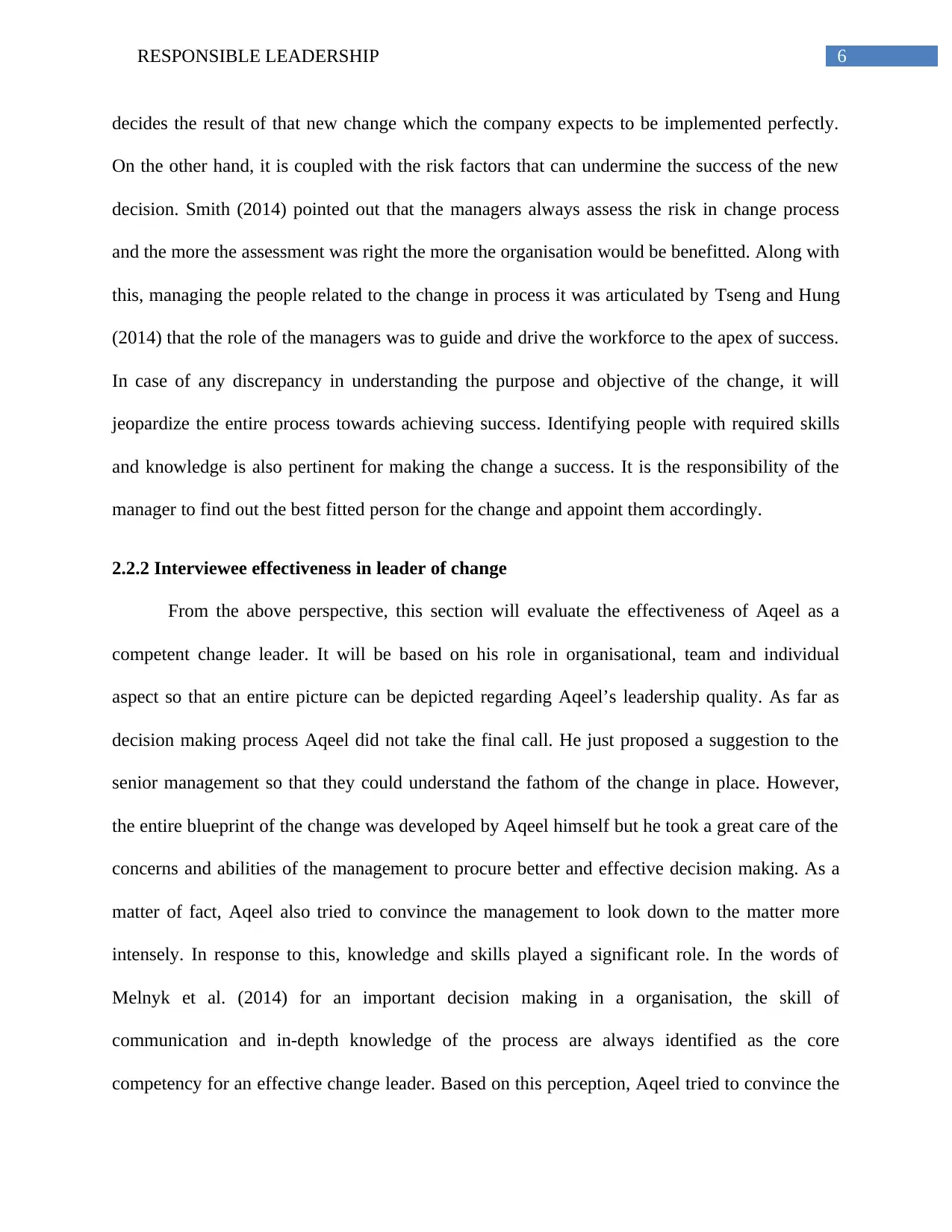
6RESPONSIBLE LEADERSHIP
decides the result of that new change which the company expects to be implemented perfectly.
On the other hand, it is coupled with the risk factors that can undermine the success of the new
decision. Smith (2014) pointed out that the managers always assess the risk in change process
and the more the assessment was right the more the organisation would be benefitted. Along with
this, managing the people related to the change in process it was articulated by Tseng and Hung
(2014) that the role of the managers was to guide and drive the workforce to the apex of success.
In case of any discrepancy in understanding the purpose and objective of the change, it will
jeopardize the entire process towards achieving success. Identifying people with required skills
and knowledge is also pertinent for making the change a success. It is the responsibility of the
manager to find out the best fitted person for the change and appoint them accordingly.
2.2.2 Interviewee effectiveness in leader of change
From the above perspective, this section will evaluate the effectiveness of Aqeel as a
competent change leader. It will be based on his role in organisational, team and individual
aspect so that an entire picture can be depicted regarding Aqeel’s leadership quality. As far as
decision making process Aqeel did not take the final call. He just proposed a suggestion to the
senior management so that they could understand the fathom of the change in place. However,
the entire blueprint of the change was developed by Aqeel himself but he took a great care of the
concerns and abilities of the management to procure better and effective decision making. As a
matter of fact, Aqeel also tried to convince the management to look down to the matter more
intensely. In response to this, knowledge and skills played a significant role. In the words of
Melnyk et al. (2014) for an important decision making in a organisation, the skill of
communication and in-depth knowledge of the process are always identified as the core
competency for an effective change leader. Based on this perception, Aqeel tried to convince the
decides the result of that new change which the company expects to be implemented perfectly.
On the other hand, it is coupled with the risk factors that can undermine the success of the new
decision. Smith (2014) pointed out that the managers always assess the risk in change process
and the more the assessment was right the more the organisation would be benefitted. Along with
this, managing the people related to the change in process it was articulated by Tseng and Hung
(2014) that the role of the managers was to guide and drive the workforce to the apex of success.
In case of any discrepancy in understanding the purpose and objective of the change, it will
jeopardize the entire process towards achieving success. Identifying people with required skills
and knowledge is also pertinent for making the change a success. It is the responsibility of the
manager to find out the best fitted person for the change and appoint them accordingly.
2.2.2 Interviewee effectiveness in leader of change
From the above perspective, this section will evaluate the effectiveness of Aqeel as a
competent change leader. It will be based on his role in organisational, team and individual
aspect so that an entire picture can be depicted regarding Aqeel’s leadership quality. As far as
decision making process Aqeel did not take the final call. He just proposed a suggestion to the
senior management so that they could understand the fathom of the change in place. However,
the entire blueprint of the change was developed by Aqeel himself but he took a great care of the
concerns and abilities of the management to procure better and effective decision making. As a
matter of fact, Aqeel also tried to convince the management to look down to the matter more
intensely. In response to this, knowledge and skills played a significant role. In the words of
Melnyk et al. (2014) for an important decision making in a organisation, the skill of
communication and in-depth knowledge of the process are always identified as the core
competency for an effective change leader. Based on this perception, Aqeel tried to convince the
Paraphrase This Document
Need a fresh take? Get an instant paraphrase of this document with our AI Paraphraser

7RESPONSIBLE LEADERSHIP
management after finding out the importance of online services in the IT service industry. As a
result of that his propositions seemed more justifiable and clear enough for the expansion of
EEMC. In course of the process Aqeel also intended to manage workforce and appointed skilled
and relevant person into the field so that they could justify with the change in process.
2.3 Lessons learned from the interview
2.3.1 Lessons learned
The interview depicts a clear objective and purpose of implementing the change. In fact,
it is important for the people associated with the changed plan to understand the objectivity and
significance of the change so that they can fix their target accordingly. According to Doppelt
(2017) getting clear perception regarding the role and purpose of the change management is
paramount for both the leaders and the workforce in order to achieving success efficiently. From
that point of view, this interview has done quite well in terms of quoting and highlighting the
purpose and aim of the change process. Along with this, the expected outcome of the new plan is
also stapled with the interview so that it will generate better framework for the change
management. As a matter of fact, this interview tries to point out that the change in process is not
a single handed operation rather it is associated with people from top to bottom. According to
Ramazani and Jergeas (2015) the success of a newly implemented organisational plan bestows
into the team management and the better communication within. Therefore, the interview also
keeps focus on the feedback and viewpoints of the senior executive. In addition to this, it can be
asserted that the interview also makes some assumptions on the behaviour of the clients. It adds
up some alternative plans in case the new service fails to satisfy the customers. Henceforth, it can
be summed up that the entire interview process rightly penetrate into the objective and strategy
management after finding out the importance of online services in the IT service industry. As a
result of that his propositions seemed more justifiable and clear enough for the expansion of
EEMC. In course of the process Aqeel also intended to manage workforce and appointed skilled
and relevant person into the field so that they could justify with the change in process.
2.3 Lessons learned from the interview
2.3.1 Lessons learned
The interview depicts a clear objective and purpose of implementing the change. In fact,
it is important for the people associated with the changed plan to understand the objectivity and
significance of the change so that they can fix their target accordingly. According to Doppelt
(2017) getting clear perception regarding the role and purpose of the change management is
paramount for both the leaders and the workforce in order to achieving success efficiently. From
that point of view, this interview has done quite well in terms of quoting and highlighting the
purpose and aim of the change process. Along with this, the expected outcome of the new plan is
also stapled with the interview so that it will generate better framework for the change
management. As a matter of fact, this interview tries to point out that the change in process is not
a single handed operation rather it is associated with people from top to bottom. According to
Ramazani and Jergeas (2015) the success of a newly implemented organisational plan bestows
into the team management and the better communication within. Therefore, the interview also
keeps focus on the feedback and viewpoints of the senior executive. In addition to this, it can be
asserted that the interview also makes some assumptions on the behaviour of the clients. It adds
up some alternative plans in case the new service fails to satisfy the customers. Henceforth, it can
be summed up that the entire interview process rightly penetrate into the objective and strategy
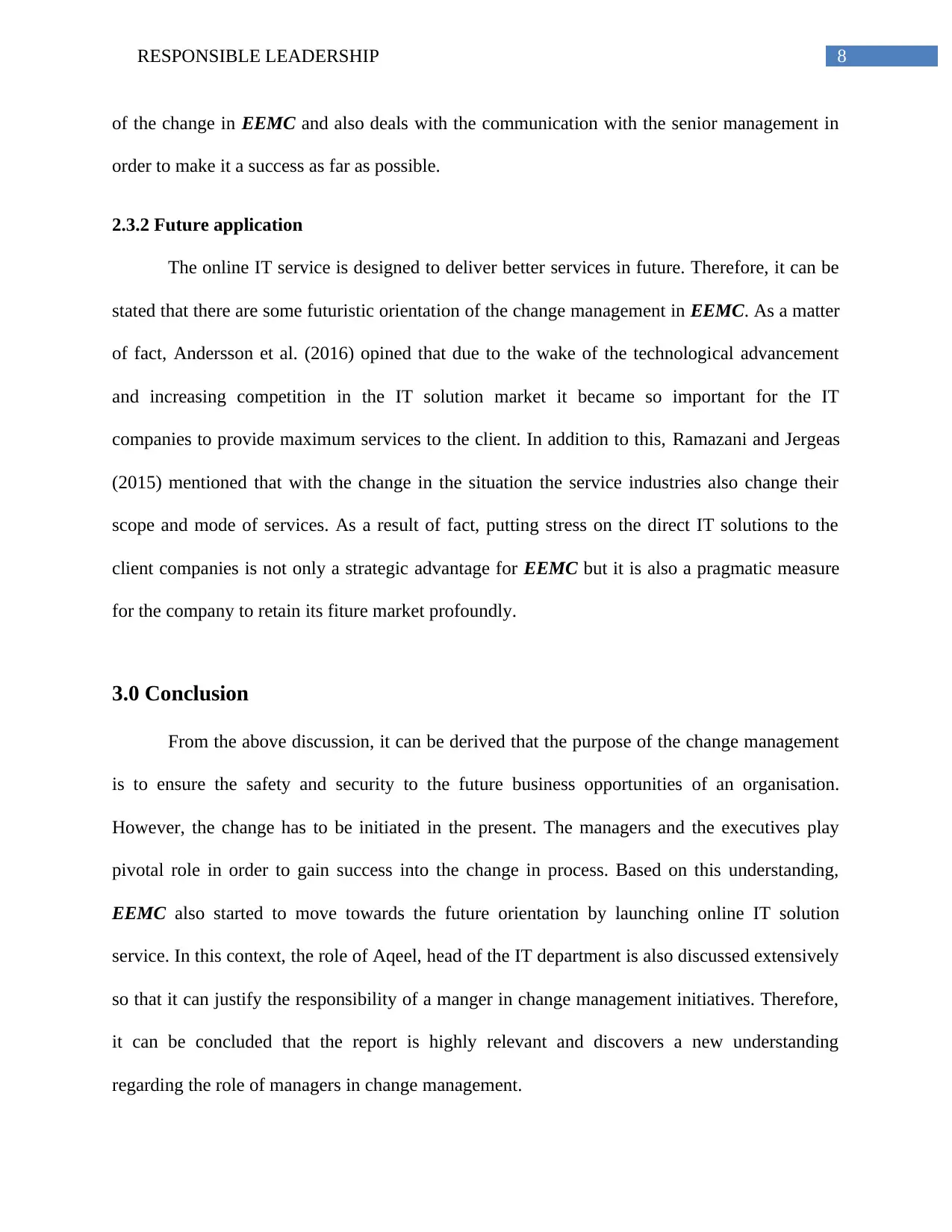
8RESPONSIBLE LEADERSHIP
of the change in EEMC and also deals with the communication with the senior management in
order to make it a success as far as possible.
2.3.2 Future application
The online IT service is designed to deliver better services in future. Therefore, it can be
stated that there are some futuristic orientation of the change management in EEMC. As a matter
of fact, Andersson et al. (2016) opined that due to the wake of the technological advancement
and increasing competition in the IT solution market it became so important for the IT
companies to provide maximum services to the client. In addition to this, Ramazani and Jergeas
(2015) mentioned that with the change in the situation the service industries also change their
scope and mode of services. As a result of fact, putting stress on the direct IT solutions to the
client companies is not only a strategic advantage for EEMC but it is also a pragmatic measure
for the company to retain its fiture market profoundly.
3.0 Conclusion
From the above discussion, it can be derived that the purpose of the change management
is to ensure the safety and security to the future business opportunities of an organisation.
However, the change has to be initiated in the present. The managers and the executives play
pivotal role in order to gain success into the change in process. Based on this understanding,
EEMC also started to move towards the future orientation by launching online IT solution
service. In this context, the role of Aqeel, head of the IT department is also discussed extensively
so that it can justify the responsibility of a manger in change management initiatives. Therefore,
it can be concluded that the report is highly relevant and discovers a new understanding
regarding the role of managers in change management.
of the change in EEMC and also deals with the communication with the senior management in
order to make it a success as far as possible.
2.3.2 Future application
The online IT service is designed to deliver better services in future. Therefore, it can be
stated that there are some futuristic orientation of the change management in EEMC. As a matter
of fact, Andersson et al. (2016) opined that due to the wake of the technological advancement
and increasing competition in the IT solution market it became so important for the IT
companies to provide maximum services to the client. In addition to this, Ramazani and Jergeas
(2015) mentioned that with the change in the situation the service industries also change their
scope and mode of services. As a result of fact, putting stress on the direct IT solutions to the
client companies is not only a strategic advantage for EEMC but it is also a pragmatic measure
for the company to retain its fiture market profoundly.
3.0 Conclusion
From the above discussion, it can be derived that the purpose of the change management
is to ensure the safety and security to the future business opportunities of an organisation.
However, the change has to be initiated in the present. The managers and the executives play
pivotal role in order to gain success into the change in process. Based on this understanding,
EEMC also started to move towards the future orientation by launching online IT solution
service. In this context, the role of Aqeel, head of the IT department is also discussed extensively
so that it can justify the responsibility of a manger in change management initiatives. Therefore,
it can be concluded that the report is highly relevant and discovers a new understanding
regarding the role of managers in change management.
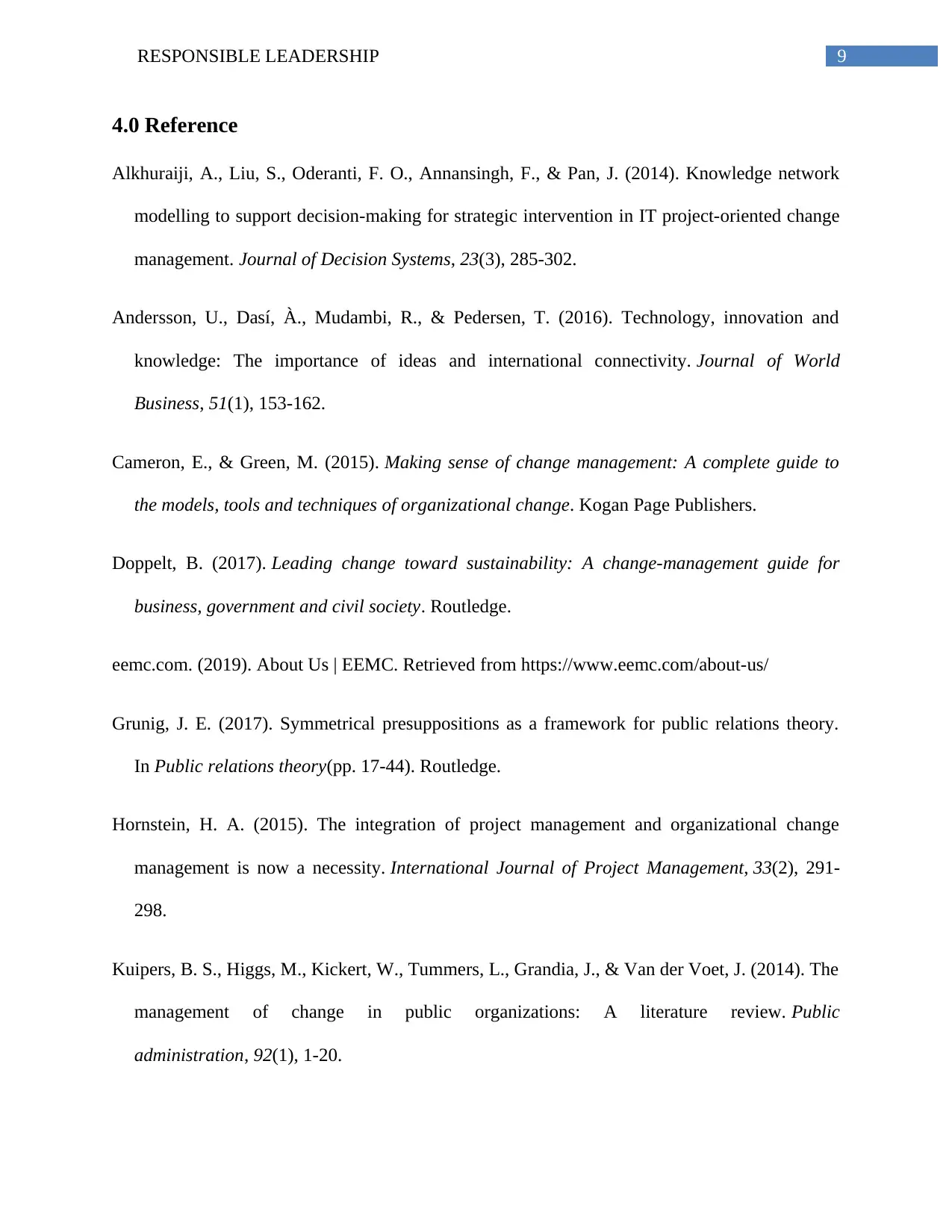
9RESPONSIBLE LEADERSHIP
4.0 Reference
Alkhuraiji, A., Liu, S., Oderanti, F. O., Annansingh, F., & Pan, J. (2014). Knowledge network
modelling to support decision-making for strategic intervention in IT project-oriented change
management. Journal of Decision Systems, 23(3), 285-302.
Andersson, U., Dasí, À., Mudambi, R., & Pedersen, T. (2016). Technology, innovation and
knowledge: The importance of ideas and international connectivity. Journal of World
Business, 51(1), 153-162.
Cameron, E., & Green, M. (2015). Making sense of change management: A complete guide to
the models, tools and techniques of organizational change. Kogan Page Publishers.
Doppelt, B. (2017). Leading change toward sustainability: A change-management guide for
business, government and civil society. Routledge.
eemc.com. (2019). About Us | EEMC. Retrieved from https://www.eemc.com/about-us/
Grunig, J. E. (2017). Symmetrical presuppositions as a framework for public relations theory.
In Public relations theory(pp. 17-44). Routledge.
Hornstein, H. A. (2015). The integration of project management and organizational change
management is now a necessity. International Journal of Project Management, 33(2), 291-
298.
Kuipers, B. S., Higgs, M., Kickert, W., Tummers, L., Grandia, J., & Van der Voet, J. (2014). The
management of change in public organizations: A literature review. Public
administration, 92(1), 1-20.
4.0 Reference
Alkhuraiji, A., Liu, S., Oderanti, F. O., Annansingh, F., & Pan, J. (2014). Knowledge network
modelling to support decision-making for strategic intervention in IT project-oriented change
management. Journal of Decision Systems, 23(3), 285-302.
Andersson, U., Dasí, À., Mudambi, R., & Pedersen, T. (2016). Technology, innovation and
knowledge: The importance of ideas and international connectivity. Journal of World
Business, 51(1), 153-162.
Cameron, E., & Green, M. (2015). Making sense of change management: A complete guide to
the models, tools and techniques of organizational change. Kogan Page Publishers.
Doppelt, B. (2017). Leading change toward sustainability: A change-management guide for
business, government and civil society. Routledge.
eemc.com. (2019). About Us | EEMC. Retrieved from https://www.eemc.com/about-us/
Grunig, J. E. (2017). Symmetrical presuppositions as a framework for public relations theory.
In Public relations theory(pp. 17-44). Routledge.
Hornstein, H. A. (2015). The integration of project management and organizational change
management is now a necessity. International Journal of Project Management, 33(2), 291-
298.
Kuipers, B. S., Higgs, M., Kickert, W., Tummers, L., Grandia, J., & Van der Voet, J. (2014). The
management of change in public organizations: A literature review. Public
administration, 92(1), 1-20.
Secure Best Marks with AI Grader
Need help grading? Try our AI Grader for instant feedback on your assignments.

10RESPONSIBLE LEADERSHIP
Melnyk, S. A., Bititci, U., Platts, K., Tobias, J., & Andersen, B. (2014). Is performance
measurement and management fit for the future?. Management Accounting Research, 25(2),
173-186.
Ramazani, J., & Jergeas, G. (2015). Project managers and the journey from good to great: The
benefits of investment in project management training and education. International Journal of
Project Management, 33(1), 41-52.
Smith, W. K. (2014). Dynamic decision making: A model of senior leaders managing strategic
paradoxes. Academy of Management Journal, 57(6), 1592-1623.
Tseng, S. C., & Hung, S. W. (2014). A strategic decision-making model considering the social
costs of carbon dioxide emissions for sustainable supply chain management. Journal of
environmental management, 133, 315-322.
Van der Voet, J. (2014). The effectiveness and specificity of change management in a public
organization: Transformational leadership and a bureaucratic organizational
structure. European Management Journal, 32(3), 373-382.\
Melnyk, S. A., Bititci, U., Platts, K., Tobias, J., & Andersen, B. (2014). Is performance
measurement and management fit for the future?. Management Accounting Research, 25(2),
173-186.
Ramazani, J., & Jergeas, G. (2015). Project managers and the journey from good to great: The
benefits of investment in project management training and education. International Journal of
Project Management, 33(1), 41-52.
Smith, W. K. (2014). Dynamic decision making: A model of senior leaders managing strategic
paradoxes. Academy of Management Journal, 57(6), 1592-1623.
Tseng, S. C., & Hung, S. W. (2014). A strategic decision-making model considering the social
costs of carbon dioxide emissions for sustainable supply chain management. Journal of
environmental management, 133, 315-322.
Van der Voet, J. (2014). The effectiveness and specificity of change management in a public
organization: Transformational leadership and a bureaucratic organizational
structure. European Management Journal, 32(3), 373-382.\

11RESPONSIBLE LEADERSHIP
Reference
https://www.eemc.com/about-us/
Reference
https://www.eemc.com/about-us/
1 out of 12
Related Documents
Your All-in-One AI-Powered Toolkit for Academic Success.
+13062052269
info@desklib.com
Available 24*7 on WhatsApp / Email
![[object Object]](/_next/static/media/star-bottom.7253800d.svg)
Unlock your academic potential
© 2024 | Zucol Services PVT LTD | All rights reserved.





